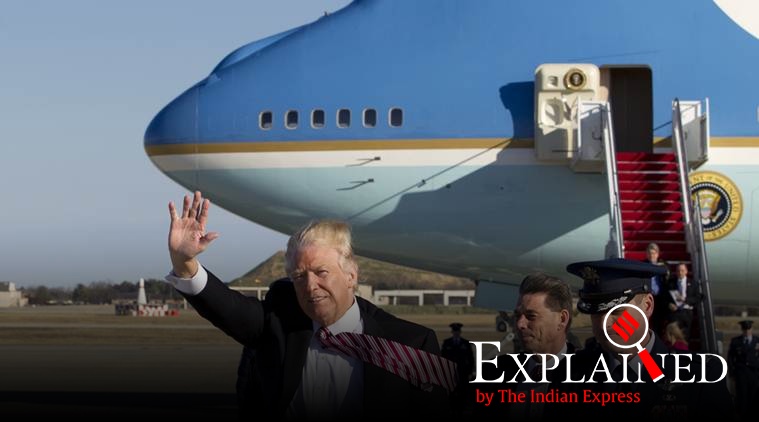
The Indian Express
Explained: Why Donald Trump wants the US to exit the Open Skies Treaty
The exit from the Open Skies Treaty is the most recent example of important pacts Washington has stepped away from during the Trump presidency, including the Paris Agreement and the Iran nuclear deal.
by Om MaratheIn a setback to the world’s arms control framework, the Trump administration on Thursday said that it will withdraw from the Open Skies Treaty (OST), a 34-member accord that allows participants to fly unarmed reconnaissance flights over any part of their fellow member states.
The move by the United States, which had been speculated for some time, has been described by Democratic Party lawmakers as a “gift” to Russian President Vladimir Putin– as it could further distance Washington from its European allies.
What is the Open Skies Treaty?
First proposed in 1955 by former US President Dwight Eisenhower as a means to deescalate tensions during the Cold War, the landmark treaty was eventually signed in 1992 between NATO members and former Warsaw Pact countries following the demise of the Soviet Union. It went into effect in 2002 and currently has 35 signatories along with one non-ratifying member (Kyrgyzstan).
The OST aims at building confidence among members through mutual openness, thus reducing the chances of accidental war. Under the treaty, a member state can “spy” on any part of the host nation, with the latter’s consent. A country can undertake aerial imaging over the host state after giving notice 72 hours before, and sharing its exact flight path 24 hours before.
The information gathered, such as on troop movements, military exercises and missile deployments, has to be shared with all member states. Only approved imaging equipment is permitted on the surveillance flights, and officials from the host state can also stay on board throughout the planned journey.
Open Skies Treaty: The US’s withdrawal
While it was envisaged as a key arms control agreement, many in Washington had for over a decade accused Russia of non-compliance with OST protocols, blaming Moscow of obstructing surveillance flights on its territory, while misusing its own missions for gathering key tactical data.
As per a report in The New York Times, President Trump was also unhappy that a Russian reconnaissance flew over his golf course in New Jersey state in 2017.
His administration has now chosen to withdraw from the pact, with Secretary of State Mike Pompeo accusing Russia of “flagrantly and continuously violating) the Treaty in various ways for years.” Russia has denied the allegations, and has called Washington’s exit as “very regrettable”.
Significance of the Open Skies Treaty
The OST was signed in 1992, much before the advent of advanced satellite imaging technology which is currently the preferred mode for intelligence gathering. Yet, as explains a report in The Economist, surveillance aircraft provide key information that still cannot be gathered by satellite sensors, such as thermal imaging data.
Also, since only the US has an extensive military satellite infrastructure, other NATO members would have to rely on Washington to obtain classified satellite data, which would be more difficult to obtain compared to OST surveillance records that have to be shared with all members as a treaty obligation.
Notably, the Economist report also mentions the OST’s utility for Washington, which since 2002 has flown 201 surveillance missions over Russia and its ally Belarus. A former Trump official had also hailed OST data gathered during the 2014 Russia-Ukraine conflict.
What US departure could mean for the treaty
In his press statement, Pompeo said that the US would reconsider its decision to withdraw if Russia “demonstrates a return to full compliance”.
This approach is reminiscent from last year when Trump had suspended US participation in the Intermediate-Range Nuclear Forces (INF) Treaty– another security agreement that had been credited with curtailing the arms race in Europe towards the end of the Cold War.
Then too, the US had said that it would re-engage with Russia if it sought a new treaty– a possibility that never materialised. Experts believe that the same could happen with the OST, with Russia using Washington’s exit as a pretext for leaving the treaty itself.
Russia’s departure could adversely impact Washington’s European allies, which rely on OST data to track Russian troop movements in the Baltic region, as per an NYT report. “Pulling out of the Open Skies Treaty, an important multilateral arms control agreement would be yet another gift from the Trump Administration to Putin,” top Democrat leaders said in a letter to Pompeo and Secretary of Defense Mark Esper.
Out of another treaty
The OST exit is only the most recent example in the list of important pacts that Washington has stepped away from during the Trump presidency, such as the Paris Agreement and the Iran nuclear deal.
Experts are now contemplating the fate of the much larger US-Russia ‘New START’ nuclear arms control agreement, which is slated to expire in February 2021. Trump has already said that his administration would not renew the treaty unless China joins. Many see this as improbable, given the already heightened tensions between Washington and Beijing over the coronavirus pandemic.